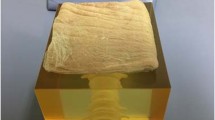Abstract
There has been little published data on the effects of temperature on the performance of dual-energy X-ray absorptiometry (DXA) machines. We examined the effect of changes in ambient room temperature on the performance of three DXA scanners (DPXL, Expert-XL and Prodigy). The study involved repeat measurements of bone mineral density (BMD) using three different spine phantoms scanned at different ambient room temperatures, both before and after calibration procedures. The calibration or quality assurance (QA) scan calibrates the scanner, adjusting for the ambient room temperature at the time of calibration. There was a moderate correlation between change in temperature and change in BMD measured prior to recalibration for the Expert-XL (r=0.58) during normal clinical scanning conditions. There was no observed change in phantom BMD with change in temperature measured using the DXPL or Prodigy. After temperature change, without repeat calibration measurements, there was a strong correlation between temperature change and change in BMD measured using the Expert-XL (r=0.96, p<0.001). From the regression equation, a change of 2.5 °C could alter the calculated BMD result measured by the Expert-XL by 1.5%, which would significantly affect the precision of the DXA system. There was no significant correlation between temperature and BMD in the DXPL or Prodigy. The observed differences between the densitometers and the effect of temperature change are most likely due to the differing types of detector systems used. Operators must be made aware that solid state detectors of the sort used in the Expert-XL (charge-coupled devices, CCDs) are significantly affected by changes in ambient room temperature.



Similar content being viewed by others
References
Mazess RB, Hanson JA, Payne R, Nord R, Wilson M. Axial and total-body bone densitometry using a narrow-angle fan-beam. Osteoporos Int 2000;11:158–66.
Barthe N, Braillon P, Ducassou D, Basse-Cathalinat B. Comparison of two Hologic DXA systems (QDR 1000 and QDR 4500/A). Br J Radiol 1997;70:728–39.
Thorpe JA, Steel SA. Image resolution of the Lunar Expert-XL. Osteoporos Int 1999;10:95–101.
Glenn F. Knoll. Radiation detection and measurements, 2nd ed. New York: Wiley, 1989.
Expert-XL imaging densitometer, reference manual. Madison, WI: Lunar Corporation, 1998.
Scientific Imaging Technologies, Inc. An introduction to scientific imaging charge-coupled devices. Beaverton, OR: Scientific Imaging Technologies, 1994.
Lang T, Takada M, Gee R, et al. A preliminary evaluation of the lunar Expert-XL for bone densitometry and vertebral morphometry. J Bone Miner Res 1997;12:136–43.
Kaye GW, Laby TH. Tables of physical and chemical constants. London: Longman, 1993.
Acknowledgements
The authors would like to thank Ian Webb, Medtel Australia, for his technical expertise.
Author information
Authors and Affiliations
Rights and permissions
About this article
Cite this article
Culton, N.L., Pocock, N.A. The effect of room temperature on dual-energy X-ray absorptiometry. Osteoporos Int 14, 137–140 (2003). https://doi.org/10.1007/s00198-002-1330-y
Received:
Accepted:
Published:
Issue Date:
DOI: https://doi.org/10.1007/s00198-002-1330-y



